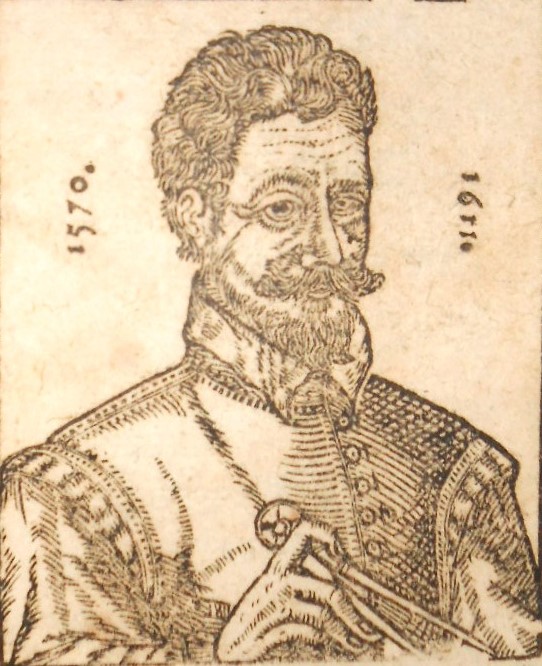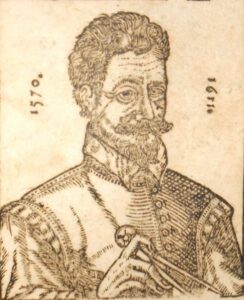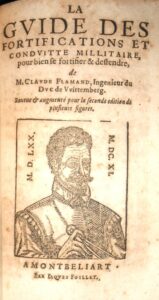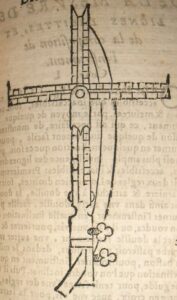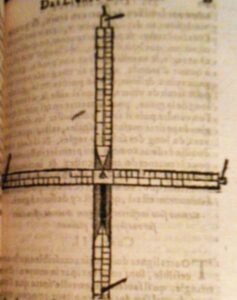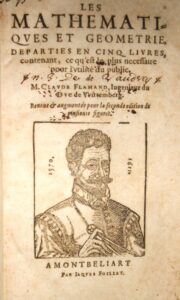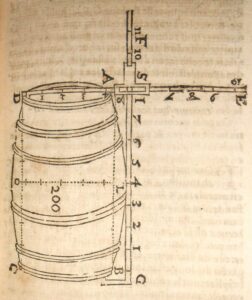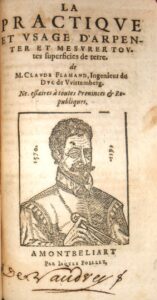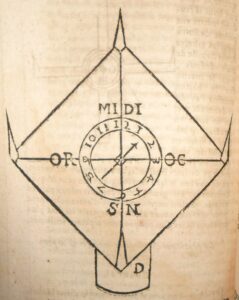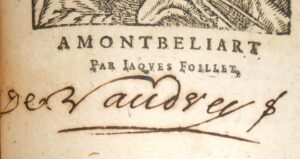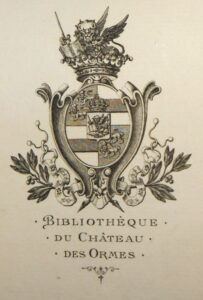Claude Flamand. Les Mathematiques et Geometrie, departies en cinq livres, contenant ce qu’est le plus necessaire pour l’utilité du public. [Bound in the suite] La Guide des fortifications et conduitte millitaire, pour bien se fortifier & deffendre. [Bound in the suite] La Practiqve et Usage d’arpenter et mesurer toutes superficies de terre […] Necessaires à toutes Provinces & Republiques. Montbeliart, Jaques Foillet, s. d. [1611]. 3 works in one volume in-8° of [8] ff, 222 pp, 1 blank page, figures in the text ; 247, [1] pp, figures in the text and 2 folding plates ; [8] ff, 125 pp, figures in the text and 1 folding plate. Marbled fawn calf, 5-ribbed spine richly decorated, red morocco title piece, gilt roulette on the edges, red speckled edges (Binding late 17th century).
First edition of La Practiqve et Usage d’arpenter et mesurer toutes superficies de terre preceded by the two works « reveue[s] & augmenté[es] pour la seconde edition de plusieurs figures » ; these were published under a common title in 1597. Each work has its own title page, decorated with a repeated portrait of the author.
Claude Flamand (died in Montbéliard in August 1626), “engineer and architect to the Prince of Montbéliard, was born in Savoyeux [in Haute-Saône], which he left because of the new religious doctrines he professed. The mathematical sciences occupied him all his life; he excelled mainly in practical geometry and architecture, on which he published three treatises”. (Fourquet). He settled in Montbéliard around 1594 and succeeded the architect Henri Schickardt in April 1610. He strengthened the fortifications of Montbéliard and worked in the county of Burgundy, Basel and Bern, as well as on the fortifications of Verdun.
His Guide des fortifications, his masterpiece, published in 1597, is one of the very first treatises on fortification written in French. The first book contains a description of devices he invented for measuring angles.
His treatise on Mathématiques et Géométrie is not without interest.
He deals masterfully with the extraction of square and cube roots, proportions, fractions, triangles, and the measurement of the circumference (without the aid of π, still unknown at the time, but approximately obtained by assuming that the circumference of the circle contains 3 times the diameter and one seventh of this diameter). The author then goes on to measure pyramids, globes and solid objects; to this end, he presents an instrument for measuring barrels: two graduated rulers, one giving the height of the barrel, the other the bottom’s diameter of each.
Finally, Flamand produced a small book on common mechanics (theory of the press, the lever, the balance, the winch, forces, etc.).
In his treatise on surveying, he also described measuring tools
and gives the different values of the foot and the acre in France, Burgundy, Lorraine, Germany, etc., while dealing with measurements of various areas, fractions, the rule of three, extractions of square roots and non-square numbers, etc.
Handwritten bookplate of “De Vaudrey” to 1st and 3rd titles.
Probably Jean-Charles de Vaudrey, who distinguished himself in the King’s service in Flanders, Ireland and Piedmont. “Captain of grenadiers in the Tournon regiment, he was the tenth to enter Coni, where he was shot with thirty-three wounds and taken prisoner. In January 1692, as a reward for his valour, the King gave him the regiment vacated by the death of the Marquis de Brac. He was killed at the battle of Cassano, in 1705, as lieutenant-general of the king’s armies and inspector of his infantry”. (Fourquet). The decoration on the back – triangular fleurons in the corners and a central diamond-shaped fleuron in the entre-nerfs – is the most common at the time and supports our attribution.
From the Voyer d’Argenson library, with the heraldic bookplate of their Château des Ormes.
« St Rémy [?] » Handwritten on verso of upper white endpaper.
Références : V. F. Goldsmith, F. 291 (Les Mathématiques) and F. 292 (La Pratique et Usage d’arpenter), cites only these two editions of 1611 and dates them [1612 ?] ; E. Fourquet, Les Hommes célèbres et les Personnalités marquantes de Franche-Comté, p. 91 for C. Flamand, and p. 52 for J. C. de Vaudrey.
The paper is sometimes of mediocre quality, with heavy freckling in some places, with some wear to the paper blurring the text, even to the point of missing parts, but in no way hindering the understanding of the text; light wetness in the first 11 quires of the copy, and, halfway down the page, in La Practiqve et Usage d’arpenter; some rare rubbing to the binding, which has 6 very small wormholes.
A good and rare copy, however, in an attractive binding.
4 800 €
